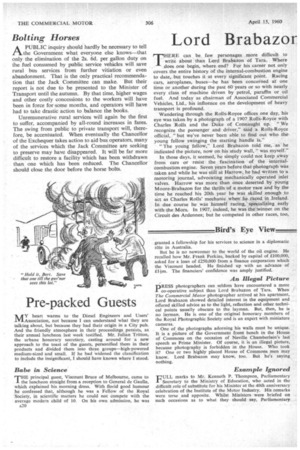Lord Brabazor
Page 22

Page 23

If you've noticed an error in this article please click here to report it so we can fix it.
Df Tara THERE can be few personages more difficult to write about than Lord Brabazon of Tara, Where does one begin, where end? For his career not only covers the entire history of the internal-combustion engine to date, but touches it at every significant point. Racing cars, aeroplanes, buses—he has been concerned at one time or another during the past 60 years or so with nearly every class of machine driven by petrol, paraffin or oil fuel. And today as chairman of Associated Commercial Vehicles, Ltd., his influence on the development of heavy transport is profound.
Wandering through the Rolls-Royce offices one day, his eye was taken by a photograph of a 1907 Rolls-Royce with Charles Rolls and the Duke of Connaught up. "We recognize the passenger and driver," said •a Rolls-Royce official, "but we've never been able to find out who theyoung fellow swinging the starting handle is."
"The young fellow," Lord Brabazon told me, . as-he indicated the picture, now on his study wall, "was myself."
In those days, it seemed, he simply Could not keep away from cars or resist the -fascination of the internalcombustion engine. Seven years before that photograph was taken and while he was still at Harrow, he had written to a motoring journal, advocating mechanically operated inlet valves. Harrow was more than once deserted by young Moore-Brabazon for the thrills of a motor race and by the time he reached his 20th year he was skilled_ enough to act as Charles Rolls' mechanic when he raced in Ireland. In due course he was himself racing, specializing early with the Mors. In 1907, indeed, he was-thea winner on the Circuit des Ardennes; but he competed in other races, too,
including the Tourist Trophy and Four-Inch Race in the Isle of Man, the Keiser Prize, Coup de Liederkirke (second) and the Grand Prix, Dieppe, in 1908.
His next phase was with the new-fangled flying machines. It was a logical sequence, because while at Cambridge, he had conceived an interest in ballooning. It is not surprising that he holds the first pilot's certificate ever granted by the Royal Aero Club, that he constructed his own aircraft at Brooklands (which, he told me, "never looked like flying ") and won the Daily Mail prize for flying a circular mile on an all-English machine in 1909.
He emerged from the 1914-18 war as a LieutenantColonel, having made his mark in the development of aerial photography, and at once soared high in civil aviation. In the days when British civil aviation was wellnigh killed by European competition and machines were not as reliable as they are today (one British pilot, handicapped by bad weather and mechanical trouble, made 33 forced landings between London and Paris and took two days on the trip), he became a member of the original civil aviation committee and of Lord Weir's advisory committee. In 1923, as chairman of the Air Mail's Committee, he gave a much-needed boost to the carriage of mail by air—an activity that had somewhat languished since it began in 1919.
The years passed, but Lord Brabazon never lost his enthusiasm for flying machines as a special case of the internal-combustion engine. Developments in the air since the 1939-45 war are stamped with the Brabazon mark, and today he is chairman of the Air Registration Board.
Member for Wallasey Nearly 30 years ago he entered the House of Commons, becoming in 1931 Member for Wallasey, a predecessor in that constituency of the present Minister of Transport, Mr. Ernest MarpIes. More than that, while representing Wallasey he was appointed Minister of Transport, holding the post between 1940 and 1941. Those were critical years for British transport. The buses had to be kept rolling, especially in the London streets damaged by fire and heavy explosive. London buses suffered many casualties, and it fell to Mr. Moore-Brabazon, as he still was, to bring provincial vehicles into the capital to stop the gaps.
His influence on public transport is undiminished nearly 20 years after those exciting times when vehicles with unfamiliar liveries—from Manchester, Yorkshire, Cardiff and elsewhere—carried Londoners about their daily business. A.E.C. continue to supply the majority of London buses as, from their historical associations with the old London General Omnibus Co., Ltd., seems only appropriate.
Lord Brabazon was appointed chairman of A.C.V. on its formation in 1951. "We're still doing well," he will tell you and counts as among the more noteworthy phenomena of recent years that a major revolution in London Transport—the gradual change-over from petrol to diesel engines —passed almost unnoticed by the general public.
What is he like, this transport man who has become a legend in his own lifetime? He is a robust figure and a hearty one, full of good stories drawn from a wealth of experiences and friendships. Brabazon and pompousness are contradictory terms. He may not do much tobogganing nowadays, but he's a good golfer and, of course, is a member of the Royal Yacht Squadron.
Of which of his many achievements is he proudest? He did not tell me; but I hazard a guess that near the top is his honorary fellowship of the Royal Photographic Society. At one time during my brief chat with him in his Berkeley Square apartment I felt it might be a little difficult to turn
the subject from cameras to transport! H.C.




























































































